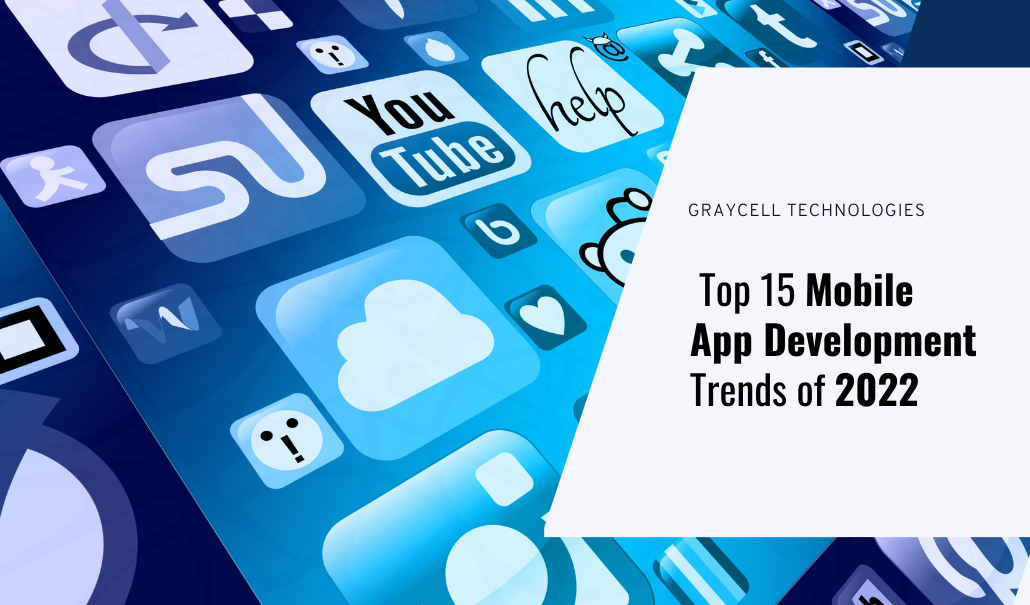Recent research shows that on average people spend a whopping 3 hours and 40 minutes per day on their phones. Whether it is organising our social lives, money transfer, playing games, watching movies or doing online business, we are all increasingly dependent on our phones. Because of that almost every company is looking forward to introducing an app for their services and products.
With each passing day, mobile app development is changing, and now the smartphone is the key to digital media success. The utilisation of wearable devices, foldable mobiles, artificial intelligence (AI), virtual reality (VI), augmented reality (AR), and mobile apps have started to influence even the smallest aspect of our daily lives.
According to Statista in 2021, in a single day smartphone users spend approx. 5 hours on the internet, and 88% of that time will be spent using apps, not browsers. If we look at the research, mobile apps are the clear winner against web browsers, and this makes mobile app development a must for businesses.
However, another side of the coin is that most mobile apps fail because they are not updated with mobile app development trends and fulfil the user requirements. This cost in losing from a competitor who is more technologically adaptable.
Top 15 mobile app development trends of 2022
To survive in this digital world, you must be aware of the latest mobile app development trends for better outcomes. Let’s discuss some of these latest trends based on analysing the needs of users.
1. 5G Network

5G technology has been around for a while but this year technology companies have started incorporating 5G at full speed. In 2021, there will be 3.5 times more 5G connections than in 2020, and these connections will nearly triple in 2022. Compared to 4G, 5G is about 100 times faster, with extremely low latency and stability. By next year, it is expected that 660 million smartphones will have a 5G connection, which is around 47.5% of all devices.
After realising the rapid expansion of 5G, more than half of mobile phones are expected to support a 5G network by the end of 2022. 5G will bring revolutionary changes in streaming 4K videos without buffering. Now handling 3D applications, VR, AR, and AI becomes possible with a wide bandwidth of 5G. In business, speed and efficiency will drastically improve with fast data transfer and advanced network reliability.
2. Artificial Intelligence and Machine Learning

People’s lives are made more efficient by Artificial Intelligence, and it’s a wide-ranging tool that changes the way people use devices and conduct business. Several tech giants like Google, Meta, and Microsoft are using artificial intelligence to automate their tasks, which saves them manpower and money.
When we first think about AI, virtual assistants like Google Assistants, Siri, and Alexa come to mind. But in 2022, AI will also power many other tools like voice translations, AI-based cameras, voice search, face unlocking, user predictions, etc.
Some of these are how AI and machine learning will impact the mobile app development landscape in :
- Users’ behaviour predictions
- Automation of IT operations
- Geophysical feature detection
- Image, face, and voice recognition
3. Beacon Technology

Today, businesspeople and retailers are utilising beacon technology to make their interactions with customers better and more effective. Beacons are mostly used in marketing to send messages to offer more customised service to customers. With the help of beacon technology, retailers can promote their services.
According to statistics, the beacon technology market is increasing at a rate of 59.8%. The approximate market value will reach $56.6 billion by 2026. That’s more than ten times higher than in 2016.
4. Blockchain

One of the most popular emerging mobile app trends nowadays is Blockchain, as it allows the design of decentralised databases. It is growing at a significant rate and is expected to accumulate $15 billion in revenue by 2023. Today, there are over 70 million blockchain wallets, and these stats also show how rapidly the number of blockchain wallet users is increasing.
In 2022 and beyond, you can expect blockchain as mainstream in software development and Blockchain as a service (BaaS) platforms. In mobile payment apps and mobile commerce apps, we can use Blockchain to prevent money and data fraud.
Future Applications of Blockchain
- Blockchain in the Anti-Piracy Sector
- Secure public elections
- Transparent betting
- Swarm Robotics
- Blockchain as service (BaaS)
5. Folding Display Apps

At the time of Flip Phones’ launch, it was found to be one of the most advanced technologies. But somehow, this device became a blur in the tech world. But over the last couple of years, these devices have managed to make a strong comeback. In recent months, we have seen the release of foldable devices like the Samsung Galaxy Fold, the Huawei Mate X, and the new Motorola Razr.
Their foldable display allows developers to create great apps that give immersive visual experiences across diverse platforms of multi-window. Responsive design with easy interaction and multi-screen multi-functional facilities are exciting features of foldable smartphones.
6. Cloud-Based Apps

It’s the most secure platform to store and access our data in the fastest way. The major advantage of cloud-integrated mobile apps is that if the user’s internal storage is less than or full, then the user can use these apps to store their data and retrieve it at any time, anywhere in a secure manner. So you don’t have to worry about having less memory while utilising these apps.
You can utilise cloud technology in mobile app development to minimise development costs, seamless database integration, higher accessibility, and cloud-based mobile application development costs with greater customer support.
7. Geolocation Based Apps

Geolocation-based app development offers personalised recommendations by collecting the users’ geolocation. These applications use locations to collect information about users’ visit locations and provide relevant information with customised solutions. This improves the overall user experience and enhances user satisfaction.
8. Mobile Wallets

The use of mobile wallets is rising at a breakneck speed. This speed is the impact of two major things. One is the current pandemic time, people are avoiding cash transactions; and the second is that people are uncomfortable sharing their card details due to lack of security or online fraud.
According to a stat, there were $6.1 billion worth of transactions from mobile wallets in 2019. This is expected to triple in 2022. Mobile Wallet integration is becoming a standard feature for every app that supports transactions.
9. Wearable Devices

From the basic fitness trackers to highly advanced smartwatches, wearable devices are ruling the world. According to reports, the sale of wearable devices reached 453 million in 2017 and by 2022 the number will touch the mark of 929 million. These devices are becoming the future of consumer technology as they are very handy, easy to use, and have multiple applications based on your needs. Therefore, app developers should get ready with apps that provide a digital experience to users on wearables.
10. On-Demand Apps

On-Demand apps are not a new concept, and the scope for these apps is seemingly endless. These apps are easy to use and have enough features to fulfil any need or service instantly. Customers can directly install the app from the app store and use the services with just a few clicks, and business owners can directly connect with the users and provide them with on-demand services.
According to Statista, mobile users spend $57.2 billion per year on on-demand services. These are some examples of the on-demand app industry:
- Doctors and fitness on-demand
- Virtual tutors and coaches
- Food and grocery delivery
- House cleaning
- Maintenance services
11. Mobile Entertainment & Gaming

In today’s digital world, some people can’t afford a single day without mobile entertainment & mobile games. Netflix has around 74% active users in the US and Canada. Whereas, gaming apps witnessed a rise of 140% in usages and downloads.
The numbers will go even up this year because they have provided easy access to entertainment and technological involvement like AR and VR, and have made games & entertainment apps more immersive.
12. Mobile Learning

No doubt Covid19 gave a boost to the market of mobile learning. According to Statista, 35% of employees use their mobile devices to learn. Mobile learning is a promising trend that has enough power to change the face of mobile app development. Mobile learning is famous for many reasons. First, it makes learning easily accessible and users can learn from anywhere. Moreover, experiences like faster learning, higher engagements made learning interactive and fun with a low course fee.
13. Super Apps

A country or a region becomes super app-ready when its maximum population has smartphones instead of desktops or laptops. Before the era of super apps, mobile app development companies designed one app for one purpose. But now, development companies are moving from one-purpose apps to one-stop solutions that solve multiple purposes.
For instance, now Facebook is no longer just a social media platform, it also offers a marketplace. Tencent’s WeChat app, which is famous as a messaging app, now also offers services like taxi rides, payments, hotel reservations, medical consultations, and more. Similarly, you can pay bills and make payments through an online shopping platform like Amazon.
14. Mobile Commerce

Mobile commerce is the process of buying and selling goods and services through wireless hand-held devices, mainly called mobile phones. According to Statista, in 2021, more than 72.9% of sales in e-commerce will be done through mobile phones, generating revenue of $3.5 trillion. During Covid19 m-commerce saw a sky-high demand for online shopping, making m-commerce a trend
From small businesses to large businesses and consumers, everyone has started relying on mobile apps. Mobile app development companies have a wide range of opportunities in M-commerce.
15. Predictive Analysis

As most companies look to value their customers more, Predictive Analysis has also become a new and significant trend in mobile app development. With the help of data analysis, AI, MI, and statistics, predictive analysis technology collects important data to predict future events. These predictions help the company to improve customer experiences. By using predictive algorithms, app developers can fulfil the client needs and customer needs as well.
Conclusion
There are millions of apps in the marketplace and millions of apps are still releasing every day in the marketplace. If you want to stay unique, all you need is to focus on these latest mobile app development trends. In 2022, these innovative mobile app development trends will see daylight and simplify our lives.
In this blog post, we have listed the top 15 mobile app development trends in 2022. To grow your business in these digitised and advanced times, hire our experts team for faster, economical, and secure mobile app development solutions. GrayCell Technologies is India’s most trusted mobile app development company that offers a comprehensive range of services from Android app development, iOS app development, digital product development, on-demand business apps, and more. We can help you establish your brand in business that provides you with a lot of opportunities to grow.






